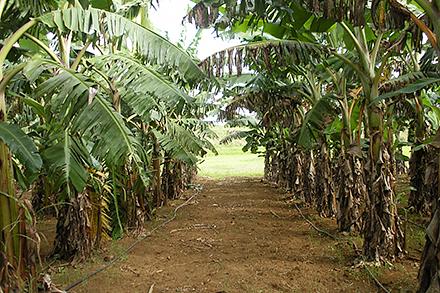A Brighter Future For An Old Favorite

ARS researchers tested new lines of plantains and bananas for tolerance to black leaf streak disease.
From Central America to Southeast Asia, plantains and bananas reign as some of the world’s most popular fruits. Both are part of Musaceae, the banana family of plants, and like all crops, they are susceptible to disease. One of the greatest disease threats for these two crops is black leaf streak disease (BLSD). The disease presents many obstacles for growers, in part because it does not affect the plants immediately. Instead, it can show up as brown spots that later disperse and form streaks or lines covering most of the leaf, causing the leaf to die and thus reducing plant photosynthetic area. In some cases, the effects can be seen in the size of the bunches of fruit and their pale, dull appearance.
Usually, growers apply fungicides to prevent BLSD from spreading. However, this treatment can be difficult because fungicides are costly and their application requires intensive labor, particularly on hill land farming where mechanization is not always possible. ARS researchers at Puerto Rico’s Tropical Crops and Germplasm Research Center have been studying banana and plantain hybrids that were developed to be resistant to BLSD. Their research revealed that the hybrids FHIA-21 (a plantain hybrid) and FHIA-17 (a banana hybrid) showed some resistance against BLSD, while also producing a good yield. However, these hybrids must be evaluated for adaptation to various soil types and conditions, and for market traits.
In comparison the traditional Maricongo plantain, the FHIA-21 hybrid produced more and superior fruit, while also exhibiting few symptoms of BLSD. The same result was obtained in the case of the FHIA-17 and traditional banana varieties. Researchers noted that the FHIA-21 and FHIA-17 hybrids take longer to harvest than the traditional ones. However, their relative advantages of production costs reduced by not needing fungicide applications and their higher yields should be weighed against their longer harvest cycle to produce a fruit bunch.
“These new hybrids will benefit farmers with higher profits without the need to incur in fungicide application costs and also the possibility of using these hybrids in organic production systems sought by consumers more often these days,” said Dr. Ricardo Goenaga, research leader at the Tropical Crops and Germplasm Research Center. — By Olga Vicente, ARS Office of Communications

